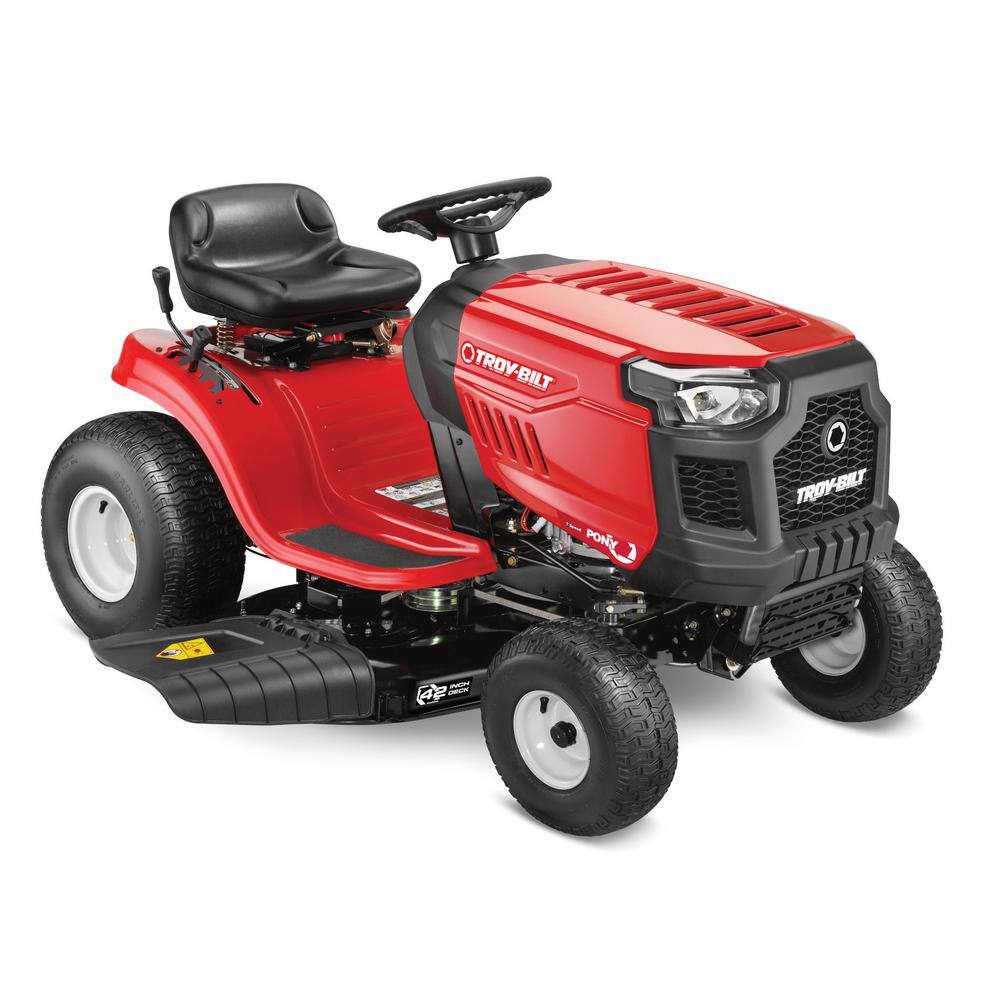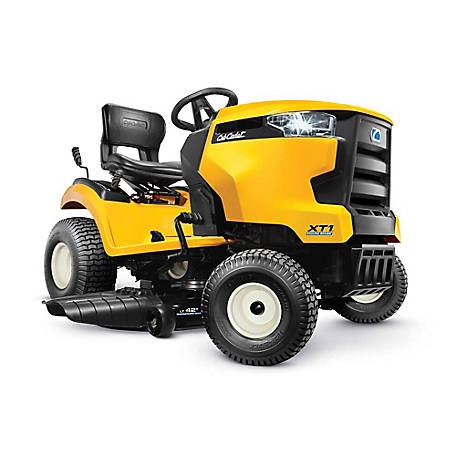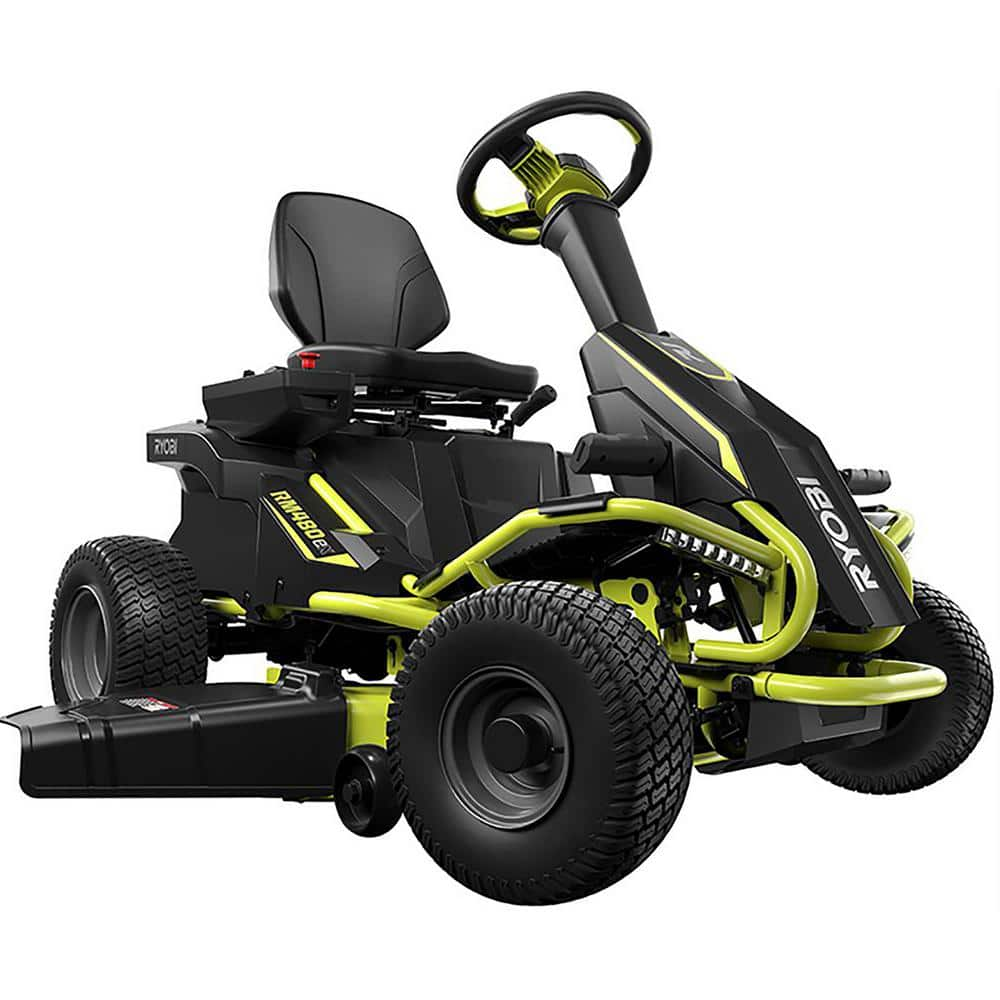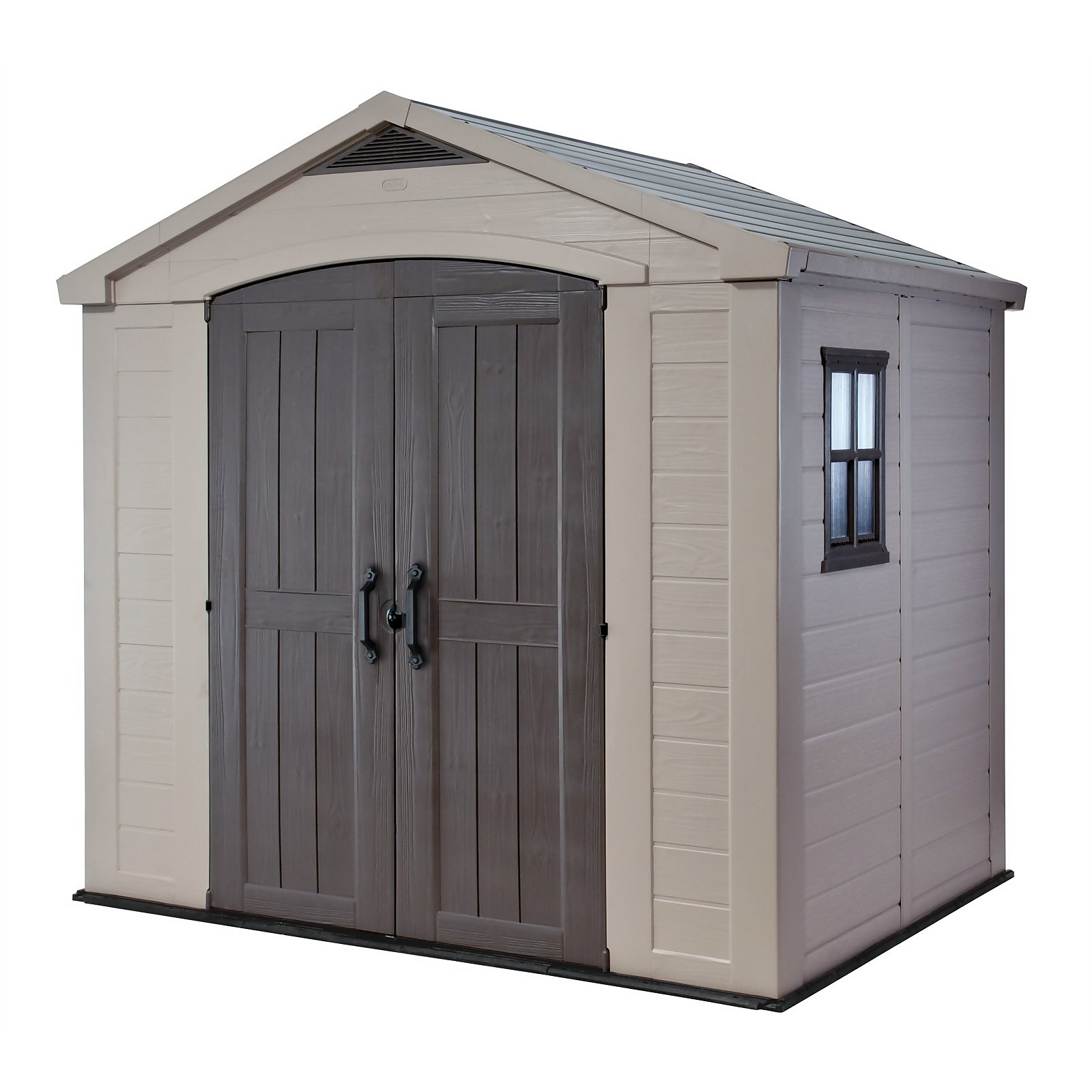Troy-Bilt Pony 42 in. 15.5 HP Briggs and Stratton Engine 7 Speed Manual Drive Gas Riding Lawn Tractor (CA Compliant)
15.5 HP 500cc single cylinder Briggs and Stratton engine. 7-speed Shift-on-the-Go transmission for easy speed adjustment. 42 in. twin blade cutting deck for lawns up to 2 acres.
Get solid, strong performance and plenty of power with the Troy-Bilt Pony 42 riding lawn tractor. The Pony lawn tractor is powered by a 15.5 HP Power Built Series (single-cylinder) OHV Briggs and Stratton engine that delivers reliable starting performance for all your mowing needs. The 7-speed Shift-on-the-Go transmission allows smooth change of speed and direction while the operator-controlled reverse mowing feature provides an alternate cutting option when you need it. Operators can easily get on and off the mower with the StepThru frame design made of fully-welded, 13-Gauge steel. Automatic headlights provide increased visibility and added safety at any time of day or night.
- For questions about service and repair, please call the Troy-Bilt customer service line (800)-828-5500, or reference the Service & Repair Document
- 7-speed shift-on-the-go transmission for smooth change of speed and direction and operator-controlled reverse mowing
- 42 in. twin-blade, side discharge deck cuts quickly and cleanly, 5-position deck height adjustment
- 13-Gauge fully-welded step-thru frame with cup holder is easy to get on and off
- 18 in. turn radius allows you to mow in tighter spaces and navigate around obstacles, trim close to trees and other landscaping features in confidence
- Comfortable low-back seat
- Increased visibility with automatic headlights
- Bagging capability allows you to collect grass clippings and the mulching capability allows you to return nutrients to the soil for a healthier lawn (rear bagger and mulch kit sold separately)
- Optional accessories include baggers, mulch kits, carts and many other attachments (sold separately)
- 2-year limited warranty
- Troy-Bilt Pony 42 CA comes fully crated and requires some assembly upon arrival
Additional information
| Assembled Depth x Height x Width (in.) | 66 x 43 x 54 |
|---|---|
| Cutting Width (in.) | 42 |
| Front Wheel Size (in.) | 15 |
| Mower Deck Width (in.) | 42 |
| Rear Wheel Size (in.) | 20 |
| Turning Radius (in.) | 18 |
| Certifications and Listings | No Certifications or Listings |
| Manufacturer Warranty | 2-year limited warranty |
Fifteen or 15 may refer to:
- 15 (number), the natural number following 14 and preceding 16
- one of the years 15 BC, AD 15, 1915, 2015
5 (five) is a number, numeral and digit. It is the natural number, and cardinal number, following 4 and preceding 6, and is a prime number. It has garnered attention throughout history in part because distal extremities in humans typically contain five digits.
Five is the third-smallest prime number, and the second super-prime, since its prime index is prime. Notably, 5 is equal to the sum of the only consecutive primes 2 + 3 and it is the only number that is part of more than one pair of twin primes, (3, 5) and (5, 7), also making it the first balanced prime with equal-sized prime gaps above and below it (of 2). 5 is the first safe prime where for a prime is also prime (2), and the first good prime, since it is the first prime number whose square (25) is greater than the product of any two primes at the same number of positions before and after it in the sequence of primes (i.e., 3 × 7 = 21 and 11 × 2 = 22 are less than 25). 11, the fifth prime number, is the next good prime, that also forms the first pair of sexy primes with 5. More significantly, the fifth Heegner number that forms an imaginary quadratic field with unique factorization is also 11 (and the first repunit prime in decimal, a base in-which five is also the first non-trivial 1-automorphic number).
Five is also the second Fermat prime, and the third Mersenne prime exponent, as well as the fourth or fifth Fibonacci number. It is also an Eisenstein prime (like 11) with no imaginary part and real part of the form . It is the first congruent number, as well as the length of the hypotenuse of the smallest integer-sided right triangle, making part of the smallest Pythagorean triple (3, 4, 5). The regular five-sided pentagon is the first regular polygon that does not tile the plane with copies of itself, and it is the largest face that a regular three-dimensional regular Platonic solid can have, as represented in the regular dodecahedron. In general, a conic curve will require five points in the same way that two points are needed to determine a line.
7 (seven) is the natural number following 6 and preceding 8. It is the only prime number preceding a cube.
As an early prime number in the series of positive integers, the number seven has greatly symbolic associations in religion, mythology, superstition and philosophy. The seven Classical planets resulted in seven being the number of days in a week. 7 is often considered lucky in Western culture and is often seen as highly symbolic. Unlike Western culture, in Vietnamese culture, the number seven is sometimes considered unlucky.
CA most often refers to:
- Canada, a country by ISO 3166-1 alpha-2 code
- California, U.S. state by postal abbreviation
CA or ca may also refer to:
An engine or motor is a machine designed to convert one or more forms of energy into mechanical energy.
Available energy sources include potential energy (e.g. energy of the Earth's gravitational field as exploited in hydroelectric power generation), heat energy (e.g. geothermal), chemical energy, electric potential and nuclear energy (from nuclear fission or nuclear fusion). Many of these processes generate heat as an intermediate energy form, so heat engines have special importance. Some natural processes, such as atmospheric convection cells convert environmental heat into motion (e.g. in the form of rising air currents). Mechanical energy is of particular importance in transportation, but also plays a role in many industrial processes such as cutting, grinding, crushing, and mixing.
Mechanical heat engines convert heat into work via various thermodynamic processes. The internal combustion engine is perhaps the most common example of a mechanical heat engine, in which heat from the combustion of a fuel causes rapid pressurisation of the gaseous combustion products in the combustion chamber, causing them to expand and drive a piston, which turns a crankshaft. Unlike internal combustion engines, a reaction engine (such as a jet engine) produces thrust by expelling reaction mass, in accordance with Newton's third law of motion.
Apart from heat engines, electric motors convert electrical energy into mechanical motion, pneumatic motors use compressed air, and clockwork motors in wind-up toys use elastic energy. In biological systems, molecular motors, like myosins in muscles, use chemical energy to create forces and ultimately motion (a chemical engine, but not a heat engine).
Chemical heat engines which employ air (ambient atmospheric gas) as a part of the fuel reaction are regarded as airbreathing engines. Chemical heat engines designed to operate outside of Earth's atmosphere (e.g. rockets, deeply submerged submarines) need to carry an additional fuel component called the oxidizer (although there exist super-oxidizers suitable for use in rockets, such as fluorine, a more powerful oxidant than oxygen itself); or the application needs to obtain heat by non-chemical means, such as by means of nuclear reactions.
Gas is one of the four fundamental states of matter. The others are solid, liquid, and plasma. A pure gas may be made up of individual atoms (e.g. a noble gas like neon), elemental molecules made from one type of atom (e.g. oxygen), or compound molecules made from a variety of atoms (e.g. carbon dioxide). A gas mixture, such as air, contains a variety of pure gases. What distinguishes gases from liquids and solids is the vast separation of the individual gas particles. This separation usually makes a colorless gas invisible to the human observer.
The gaseous state of matter occurs between the liquid and plasma states, the latter of which provides the upper-temperature boundary for gases. Bounding the lower end of the temperature scale lie degenerative quantum gases which are gaining increasing attention. High-density atomic gases super-cooled to very low temperatures are classified by their statistical behavior as either Bose gases or Fermi gases. For a comprehensive listing of these exotic states of matter, see list of states of matter.
A lawn () is an area of soil-covered land planted with grasses and other durable plants such as clover which are maintained at a short height with a lawn mower (or sometimes grazing animals) and used for aesthetic and recreational purposes—it is also commonly referred to as part of a garden. Lawns are usually composed only of grass species, subject to weed and pest control, maintained in a green color (e.g., by watering), and are regularly mowed to ensure an acceptable length. Lawns are used around houses, apartments, commercial buildings and offices. Many city parks also have large lawn areas. In recreational contexts, the specialised names turf, pitch, field or green may be used, depending on the sport and the continent.
The term "lawn", referring to a managed grass space, dates to at least the 16th century. With suburban expansion, the lawn has become culturally ingrained in some areas of the world as part of the desired household aesthetic. However, awareness of the negative environmental impact of this ideal is growing. In some jurisdictions where there are water shortages, local government authorities are encouraging alternatives to lawns to reduce water use. Researchers in the United States have noted that suburban lawns are "biological deserts" that are contributing to a "continental-scale ecological homogenization." Lawn maintenance practices also cause biodiversity loss in surrounding areas.
A pony is a type of small horse (Equus ferus caballus). Depending on the context, a pony may be a horse that is under a given height at the withers, or a small horse with a specific conformation and temperament. Compared to a larger horse, a pony may have a thicker coat, mane and tail, with proportionally shorter legs, a wider barrel, heavier bone, a thicker neck and a shorter, broader head. The word pony derives from the old French poulenet, meaning foal, a young, immature horse.: 1041
Small horses and ponies were traditionally used for riding, driving and as pack beasts. During the Industrial Revolution, particularly in Great Britain, many were used as pit ponies, hauling loads of coal in the mines. In the modern era they may be kept as children's mounts, for recreational or competitive riding or driving, or for cultural or conservation reasons.
In modern use, some organizations may define a pony as a mature horse below a certain height at the withers; this may vary from about 142 cm (14.0 h) to nearly 150 cm (14.3 h). (Note: 14.3 hands means 14 hands and 3 inches, ie decimally 14.75 hands.) Some people classify an animal as either horse or pony from its pedigree and phenotype, no matter what its height. A full-sized horse may sometimes even be called a pony as a term of endearment.
In everyday use and in kinematics, the speed (commonly referred to as v) of an object is the magnitude of the change of its position over time or the magnitude of the change of its position per unit of time; it is thus a scalar quantity. The average speed of an object in an interval of time is the distance travelled by the object divided by the duration of the interval; the instantaneous speed is the limit of the average speed as the duration of the time interval approaches zero. Speed is the magnitude of velocity (a vector), which indicates additionally the direction of motion.
Speed has the dimensions of distance divided by time. The SI unit of speed is the metre per second (m/s), but the most common unit of speed in everyday usage is the kilometre per hour (km/h) or, in the US and the UK, miles per hour (mph). For air and marine travel, the knot is commonly used.
The fastest possible speed at which energy or information can travel, according to special relativity, is the speed of light in vacuum c = 299792458 metres per second (approximately 1079000000 km/h or 671000000 mph). Matter cannot quite reach the speed of light, as this would require an infinite amount of energy. In relativity physics, the concept of rapidity replaces the classical idea of speed.
A tractor is an engineering vehicle specifically designed to deliver a high tractive effort (or torque) at slow speeds, for the purposes of hauling a trailer or machinery such as that used in agriculture, mining or construction. Most commonly, the term is used to describe a farm vehicle that provides the power and traction to mechanize agricultural tasks, especially (and originally) tillage, and now many more. Agricultural implements may be towed behind or mounted on the tractor, and the tractor may also provide a source of power if the implement is mechanised.






by Ruva
A little slow compared to my Husqvarna Riding Lawn Mower other than that its good.
by Charles
Really like my Troy-Bilt Pony 42 except one thing when i went to put on the seat two of the bolt was not there the seat is hold on one bolt that not good thing.
by Lesley
Drained a brand new battery in 2 weeks right after receiving the mower for no apparent reason that we can find. Other than that, it’s great. Now we unhook the battery completely between mows and we have no troubles.
by Tom
Great product and customer service. Received in a very timely manner.
by Terri
Very happy with mower. Just the right size for my yard. So much easier than the push mower since the yard seemed to keep getting bigger every time I mowed.